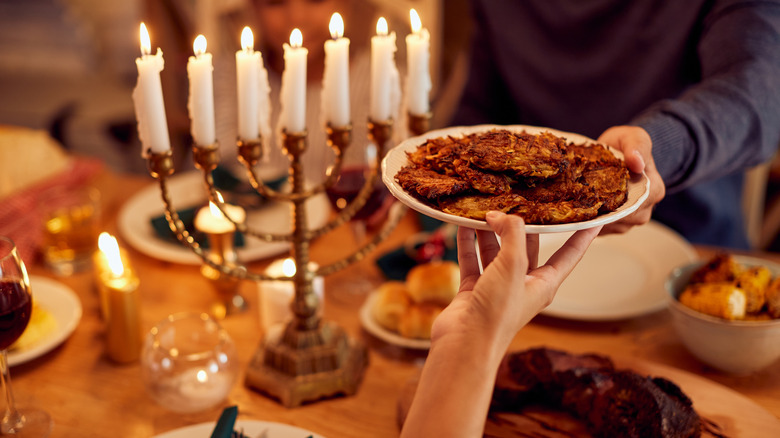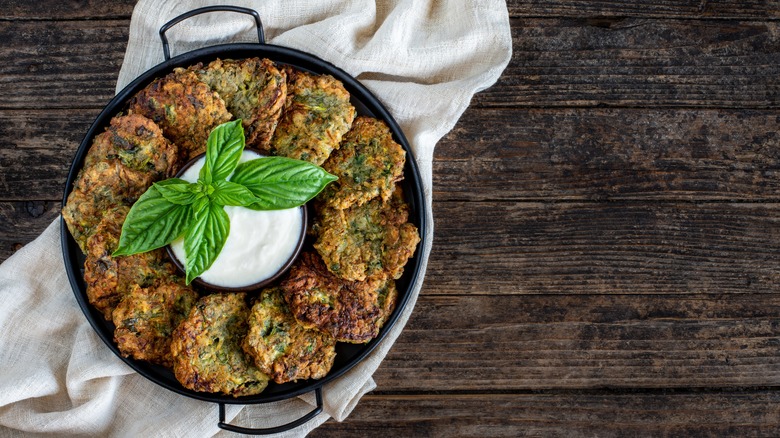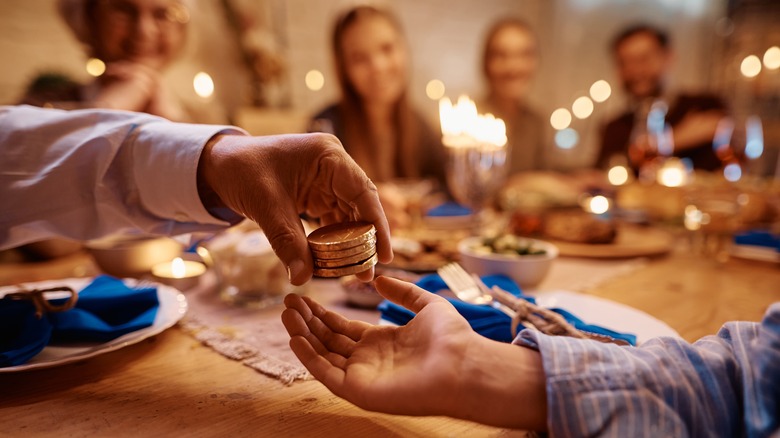The Symbolic Reasoning Behind Eating Latkes On Hanukkah
Latkes are almost as iconic to the Jewish holiday of Hanukkah as the symbolic Menorah. The small potato pancakes, which are fried in oil and dipped in apple sauce or sour cream, are served each year over the course of the eight-night holiday Hanukkah in addition to the lighting of the menorah. But how exactly did the classically crispy latke make its way into Hanukkah celebrations?
Well, it all comes down to the oil. Latkes, like many traditional Hanukkah foods, are fried in oil. This oil is central to the Jewish holiday, which commemorates the story of the Maccabees, a group of Jewish rebels who, in 164 BCE, overthrew the tyranny of Greek and Syrian forces attempting to impose their religion on the Jewish people. When the Maccabees retook one of their temples, they found only enough oil for their ceremonial candelabra to last one day. But as the story goes, the oil kept the candles burning past longer than would have been expected, lasting eight days, long enough for new, purified oil to reach them.
The word Hanukkah means 'dedication,' in Hebrew and refers to the Maccabees' work to rededicate their altar after reclaiming it, and the miracle of the oil stretching over eight days is a key aspect of the story. In subsequent observations of the holiday, oil has played a key role in the eight-day-long Jewish holiday, and one such place is in the food served at Hanukkah.
How potatoes came into the picture
Today, the delicious little fried potato pancakes we know as latkes are synonymous with the Jewish holiday of Hanukkah, however, those tasty little potato fritters weren't always a part of Hanukkah celebrations. In fact, potatoes didn't exist outside of the Americas when the first Hanukkah took place. So how did latkes come to be an essential part of the eight-night event?
The answer starts with the story of Judith and Holofernes (sort of). PBS explains that in the story, Judith's hometown of Bethulia was invaded by a group of Assyrians led by Holofernes. In order to win back control of her hometown, Judith snuck in to see Holofernes and fed him salty cheese, which prompted him to drink wine and fall asleep. Once Holofernes was asleep, Judith chopped off his head, ultimately scaring away his forces. In honor of this story of resistance and dedication, many Jewish people began frying cheese in oil as a part of Hanukkah celebrations. This would make cheese pancakes the original latke, so to speak. The cheese-based pancake, called cassola, originated in Italy in the 15th century. These cakes used ricotta and were cooked in honor of Judith.
Potatoes didn't come to be used in latkes until the late 18th century in Europe. The use of potatoes for latkes was popularized due to a series of crop failures and devastating famines which led to the widespread use of the hearty potato. Since then, potato latkes have become essential in many Jewish households during Hanukkah, where the oil-rich food serves as a symbol of the miracle of long-lasting oil at the Temple of Jerusalem.
Hanukkah beyond latkes
But latkes aren't the only treat served during Hanukkah. Other fried foods, such as sufganiyot are also served during Hanukkah. Sufganiyot are fried custard or jelly-filled doughnuts. Sufganiyot, like latkes, are fried in oil, making them the perfect Hanukkah treat. And like latkes, sufganiyah were not served at the first celebrations of Hanukkah. Instead, the food was developed over the centuries, most likely originating from similar Moroccan or Algerian treats while the jelly filling was most likely added in Europe, where the treat really took root.
Not all of the foods served during Hanukkah are fried though; perhaps the most iconic of these non-fried treats is Hanukkah gelt or chocolate coins wrapped in gold foil. Hanukkah gelt comes from centuries-old Hanukkah traditions and is usually given to children over the course of Hanukkah as a supplement or replacement for a monetary present.
Of course, these are just some of the foods served over Hanukkah. Many families and regions have their own specific Hanukkah traditions involving a number of different foods. Even if you don't celebrate Hanukkah, exploring its rich history and tradition can make for some pretty delicious discoveries — pass the latkes and sour cream, please.


